Compass acquires Contactually, a CRM provider to the real estate industry
Compass, the real estate tech platform that is now worth $4.4 billion, has made an acquisition to give its agents a boost when it comes to looking for good leads on properties to sell. It is acquiring Contactually, an AI-based CRM platform designed specifically for the industry, which includes features like linking up a list of homes sold by a brokerage with records of sales in the area and other property indexes to determine which properties might be good targets to tap for future listings.
Contactually had already been powering Compass’s own CRM service that it launched last year, so there is already a degree of integration between the two.
Terms of the deal are not being disclosed. Crunchbase notes that Contactually had raised around $18 million from VCs that included Rally Ventures, Grotech and Point Nine Capital, and it was last valued at around $30 million in 2016, according to PitchBook. From what I understand, the startup had strong penetration in the market, so it’s likely that the price was a bit higher than this previous valuation.
The plan is to bring over all of Contactually’s team of 32 employees, led by Zvi Band, the co-founder and CEO, to integrate the company’s product into Compass’s platform completely. They will report to CTO Joseph Sirosh and head of product Eytan Seidman. It will also mean a bigger operation for Compass in Washington, DC, which is where Contactually had been based.
“The Contactually team has worked for the past 8 years to build a best-in-class CRM that aggregates relationships and automatically documents every touchpoint,” said Band in a statement “We are proud that our investment into machine learning has resulted in new features like Best Time to Email and other data-driven, follow-up recommendations which help agents be more effective in their day-to-day. After working extensively with the Compass team, it was apparent that joining forces would accelerate our missions of building the future of the industry.”
For the time being, customers who are already using the product — and a large number of real estate brokers and agents in the U.S. already were, at prices that ranged from $59/month to $399/month depending on the level of service — will continue their contracts as before.
I suspect that the longer-term plan, however, will be a little different: You have to wonder if agents who compete against Compass would be happy to use a service where their data is being processed by it, and for Compass itself. I would suspect that having this tech for itself would give it an edge over the others.
Compass, I understand from sources, is on track to make $2 billion in revenues in 2019 (its 2018 targets were $1 billion on $34 billion in property sales, and it had previously said it would be doubling that this year). Now in 100 cities, it’s come a long way from its founding in 2012 by Ori Allon and Robert Reffkin.
The bigger picture beyond real estate is that, as with many other analog industries, those who are tackling them with tech-first approaches are sweeping up not only existing business, but in many cases helping the whole market to expand. Contactually, as a tool that can help source potential properties for sale that owners hadn’t previously considered putting on the market, could end up serving that very end for Compass.
The focus on using tech to storm into a legacy industry is also coming at an interesting time. As we’ve pointed out before, the housing market is predicted to cool this year, and that will put the squeeze on agents who do not have strong networks of clients and the tools to maximise whatever opportunities there are out there to list and sell properties.
The likes of Opendoor — which appears to be raising money and inching closer to Compass in terms of valuation — is also trying out a different model, which essentially involves becoming a middle part in the chain, buying properties from sellers and selling them on to buyers, to speed up the process and cut out some of the expenses for the end users. That approach underscores the fact that, while the infusion of technology is an inevitable trend, there will be multiple ways of applying that.
This appears to be Compass’s first full acquisition of a tech startup, although it has made partial acqui-hires in the past.
Powered by WPeMatico
Pokémon Sword and Shield to land on Nintendo Switch this year
Nintendo and The Pokémon Company have unveiled the next Pokémon game in the main series. The new game will come in two variants later this year — Pokémon Sword and Pokémon Shield.
Nintendo announced the new game in a Pokémon Direct live stream. And if you’ve been playing Pokémon in the past, you’ll feel right at home. The design of the world and the characters look just like Pokémon Let’s Go on the Nintendo Switch, but with more details.
There will be a new region called Galar and it vaguely looks like the U.K. In addition to cities, you’ll be walking around mountains, caverns and woods. And, of course, there will be new monsters, new gym leaders, new fights and a blank Pokédex to fill.
Seeing this brand new world feels surreal when you think about the Game Boy days. Nintendo is probably going to sell a ton of games to new players and older players who still have fond memories of the early days of the franchise.
The new starting roster is made of three different monsters — Grookey, Scorbunny and Sobble. You’ll have plenty of time to think about your pick as the game should hit the stores at the end of 2019.
Powered by WPeMatico
TikTok is launching a series of online safety videos in its app
On the heels of news that TikTok has reached 1 billion downloads, the company today is launching a new initiative designed to help inform users about online safety, TikTok’s various privacy settings and other controls they can use within its app, and more. Instead of dumping this information in an in-app FAQ or help documentation, the company will release a series of video tutorials that are meant to be engaging and fun, in order to better resemble the other content on TikTok itself.
The safety series, called “You’re in Control,” will star TikTok users and make use of popular memes, in-app editing tricks and other effects, just like other TikTok videos do. The videos will appear in the app and be available through the new @tiktoktips account.
The videos will focus on a range of privacy, safety and well-being settings and other safety-related policies. This includes TikTok’s Community Guidelines, how in-app reporting works, plus other settings for protecting your privacy, how to control comments, settings to manage your screen time and more.
They’re not exactly your traditional how-to videos, however.
Instead, the videos showcase what’s often more serious issues — like being overrun with unwanted messages — in a humorous fashion. For example, in the video about configuring your message controls, angry commenters are depicted as shouting passengers on an airplane while the user is depicted by an overwhelmed flight attendant.

“Too many DMs?,” the video asks. The flight attendant snaps his fingers, which causes most of the passengers to disappear. The scene returns to peace and quiet. It’s a simple enough analogy for TikTok’s younger user base to understand.
This is then followed by a screen recording that shows you how to turn off messaging within the TikTok app’s settings.
Other videos have a similar style.
A barking, growling dog is used to demonstrate Restricted Mode, for instance. A noisy crowd overlooking someone’s shoulder is the intro on the video about using comment controls.
Another video encourages the use of screen time controls, asking “can’t put your phone down?” and shows someone so wrapped up in their phone they aren’t watching where they’re walking.
But the video about the Community Guidelines is maybe the most cringe-y, as it feels a bit like your parents reminding you to “play nice.” However, it still manages to set a tone for what TikTok wants to promote — a community for “positive vibes” where everyone feels “safe and comfortable.”
At launch, there are seven of these short-form videos in the safety series, which will launch in the TikTok app in the U.S. and U.K on Wednesday. In time, the company plans to add other tutorials and expand the series across its global markets, it says.
Of course, TikTok needs more than a series of videos to make its app a safe and welcoming community, the way it desires. It also needs a combination of policies, settings, controls, technology, moderation and more, the company says. And it needs to comply with COPPA laws – which it’s basically skirting.
That said, a focus on user education is an important aspect to this larger goal — and it stands in stark contrast to how Facebook intentionally made its privacy settings so complex and difficult to find and use for so many of its earlier years that people gave up trying.
How well TikTok can execute on user privacy and safety as the app grows still remains to be seen. For now, it tends to be talked about as either a wholesome and fun video experience, or an online cesspool filled with hateful content and child predators. It’s an app on the internet, so both versions of this story are likely true.
There is no large user-generated content site — even those run by Facebook, Twitter and YouTube — that has figured out how to properly police the hatefulness and evil contained in humanity. But TikTok, at least, takes care not to showcase that content in its main feed — you have to seek it out directly (or train its algorithm by never clicking on anything wholesome).
But, so far, TikTok has been better reviewed by child safety advocates than you might expect. For instance, Common Sense Media — a nonprofit that provides unbiased and trusted advice about all sorts of media, including apps — said that the app, used with parental supervision, can be “a kid-friendly experience.”
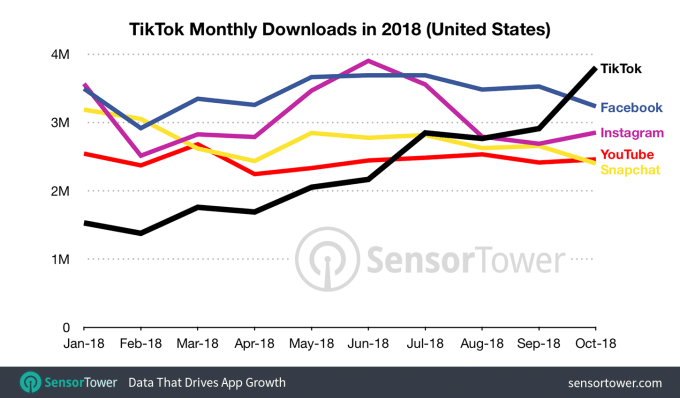
The launch of the video series comes at a time when TikTok’s growth is surging. The app recently surpassed a billion installs across the iOS App Store and Google Play, including Lite versions and regional variations, but excluding Android installs in China, according to data from Sensor Tower.
Roughly 25 percent of those installs are from India, the report said. And around 663 million of TikTok’s total installs occurred in 2018, which made the app the No. 4 most downloaded non-game for the year.
However, installs alone don’t tell the story of how many people actually use the app or how often. And a chunk of these could be the same user installing the app on multiple devices, or even bots used to push the app up the charts. In addition, parents often download the app their tween or teen is using for monitoring purposes, but don’t engage with the app or its content on a regular basis.
Below, is a compilation of all the new videos launching today:
Powered by WPeMatico
The Shadow Ghost turns cloud gaming into a seamless experience
French startup Blade, the company behind Shadow, is launching a new set-top box to access its cloud gaming service — the Shadow Ghost. I’ve been playing with the device for a couple of weeks and here’s my review.
The Shadow Ghost is a tiny little box that doesn’t do much. The true magic happens in a data center near your home. When you sign up to Shadow, you don’t even have to get a box. You can simply subscribe to the service without any hardware device and use the company’s apps instead.
Shadow is a cloud computing service for gamers. For $35 per month, you can access a gaming PC in a data center and interact with this computer. Right now, Shadow gives you eight threads on an Intel Xeon 2620 processor, an Nvidia Quadro P5000 GPU that performs more or less as well as an Nvidia GeForce GTX 1080, 12GB of RAM and 256GB of storage. You can optionally get more storage with an extra subscription. It’s a full Windows 10 instance and you can do whatever you want with it.
Most subscribers now access Shadow using one of the company’s apps on Windows, macOS or Linux. You also can connect to your virtual machine from your iOS or Android phone or tablet. And now, you can buy the Shadow Ghost if you want to use the service on a TV or without a computer.
I first used Shadow during the early days of the service back in early 2017. My first experience of the service felt like magic. Thanks to my high-speed fiber connection, I could play demanding games on a laptop. The best part was that the laptop fan would remain silent.
But it wasn’t perfect. Nvidia driver updates failed sometimes. Or your virtual machine would become completely unaccessible without some help from the customer support team.
In other words, the concept was great, but the service wasn’t there yet.
Things have changed quite drastically after years of iteration on the apps, the streaming engine, the infrastructure and even the GPUs in the data centers. Blade co-founder and CEO Emmanuel Freund told me that the service has been working fine for just a few months.
It’s no surprise that those technical improvements have led to less churn, more referrals and more subscriptions. In July 2018, the startup had 20,000 subscribers. Now there are 65,000 subscribers. There’s even more demand, but the company has had a hard time keeping up with new machines in data centers.
Shadow is currently available in France, the U.K., Germany, Belgium, Luxembourg, Switzerland and parts of the U.S. The company simply can’t accept customers from anywhere in the world because they need to live near a data center with Shadow servers.
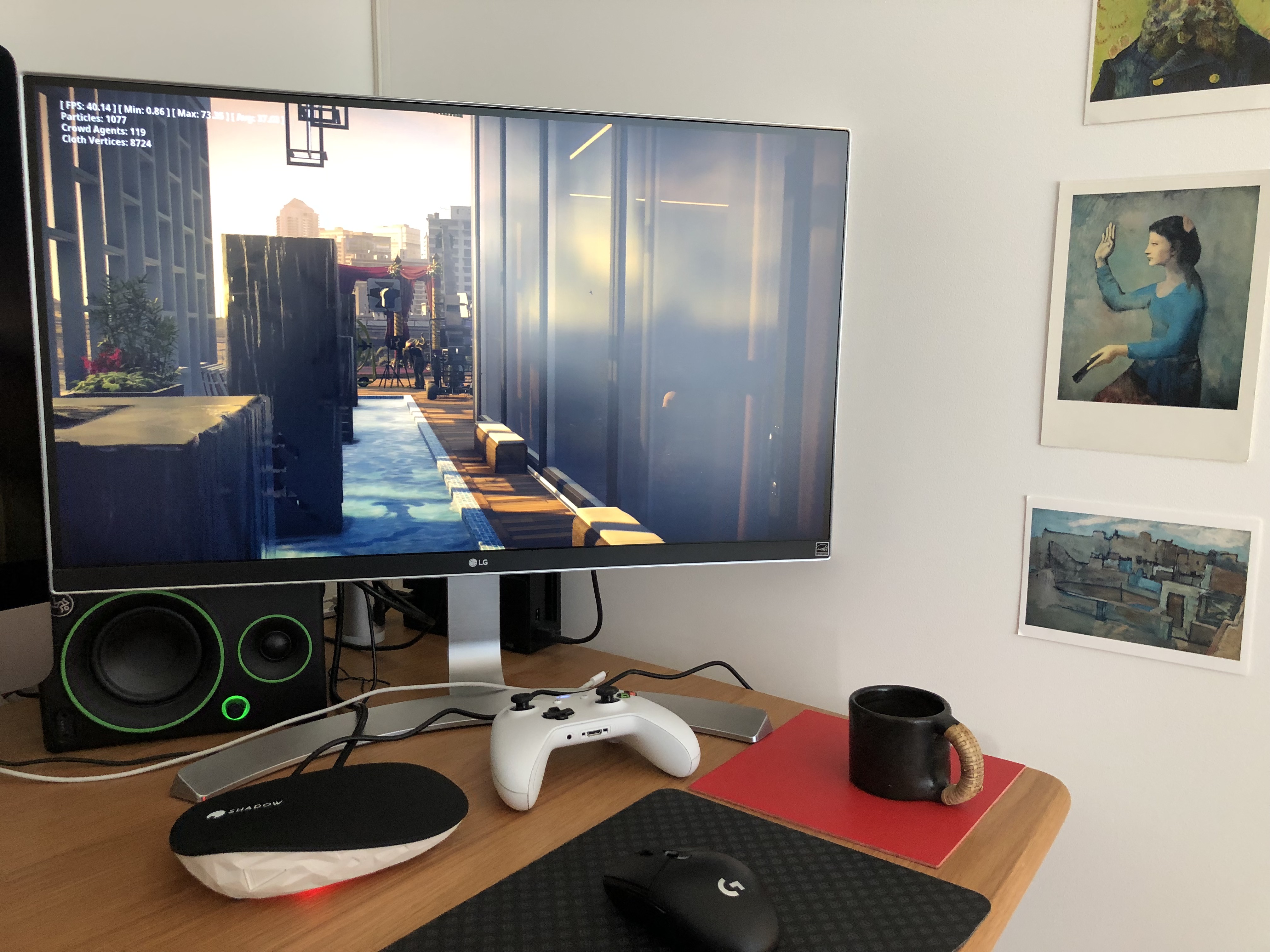
Playing with the Shadow Ghost
The original Shadow box was a bit clunky. You could hear the fan, you had to rely on dongles if you wanted to pair a Bluetooth device or connect to a Wi-Fi network and there was no HDMI port — only DisplayPort. Internally, Blade has been debating whether the company needs another box.
In 2017, it was too hard to explain the product without some sort of physical device — you can replace a PC tower with a tiny box. But now that gamers understand the benefits of cloud gaming, there’s no reason to force you to buy a box.
And yet, the Shadow Ghost can be a useful little device in some cases. For instance, while the company has released an Android TV app and is testing a new app for the Apple TV, your current TV setup might not be compatible with Shadow. Or maybe you primarily use a laptop and you want to create a desktop PC setup with a display, a keyboard, a mouse and a Shadow Ghost.
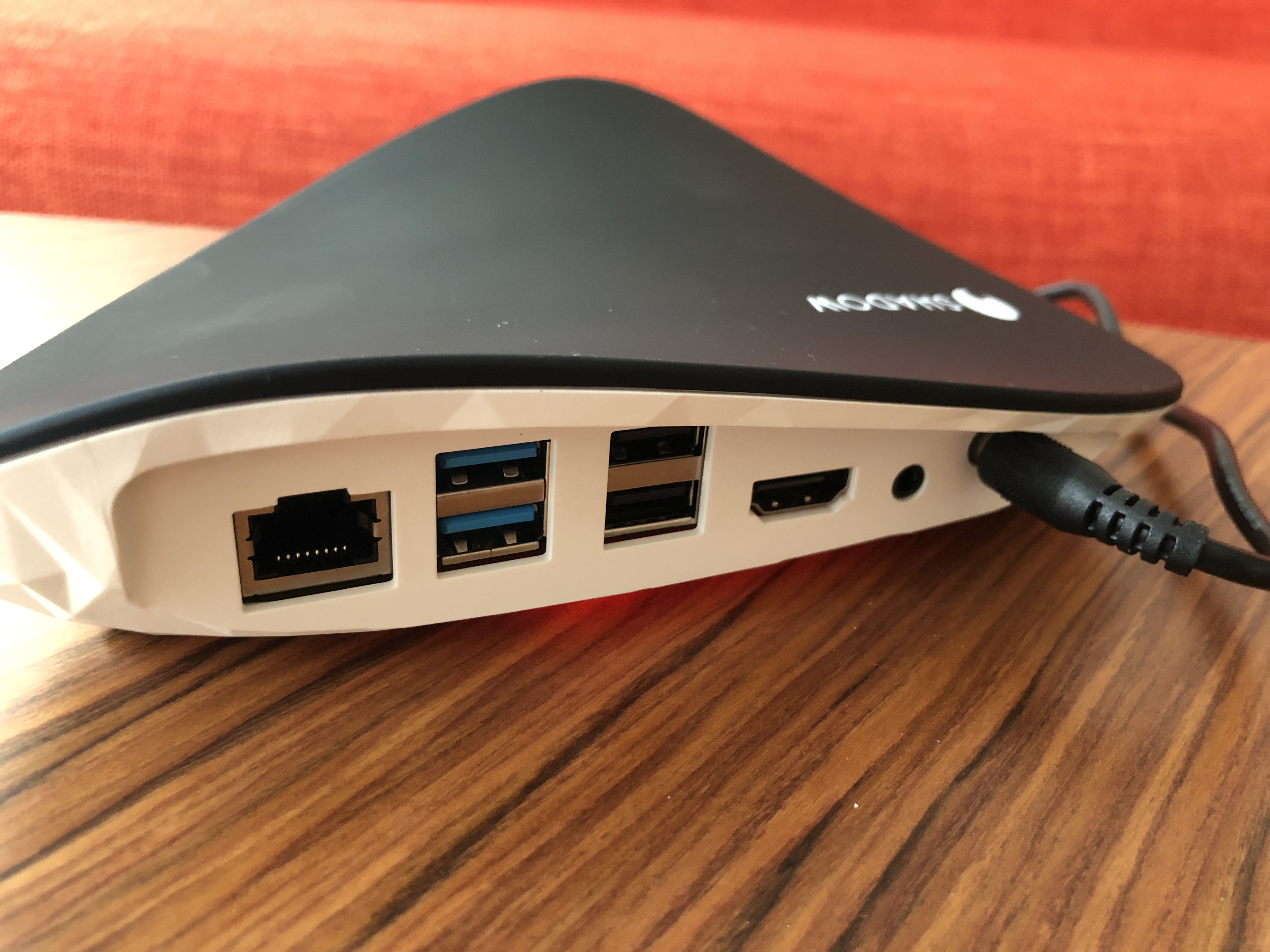
Everything has been improved. It is now a fanless device that consumes less than 5W when it’s on. It has an Ethernet port, two USB 3.0 ports, two USB 2.0 ports, an audio jack and a single HDMI port. Bluetooth and Wi-Fi have finally been integrated in the device.
When you boot up the device, you get a menu to connect to a Wi-Fi network or control your Bluetooth devices. You also can change some streaming settings, like in the app launcher.
Once you press the start button, the video stream starts and it feels like you’re using a Windows computer. With Steam’s Big Picture mode, you get a convenient setup for couch gaming. I had no issue playing demanding games, such as Hitman 2. It works perfectly fine with a Wi-Fi connection and a Bluetooth controller.
Using the Shadow Ghost feels just like using the Shadow app on a computer. So it’s hard to say whether you need the Shadow Ghost or not. It depends on your setup at home and how you plan to use the service.
Last summer, Blade planned to manufacture 5,000 units. But now that the user base has grown significantly, that first batch could disappear in no time. It is available starting today for $140.
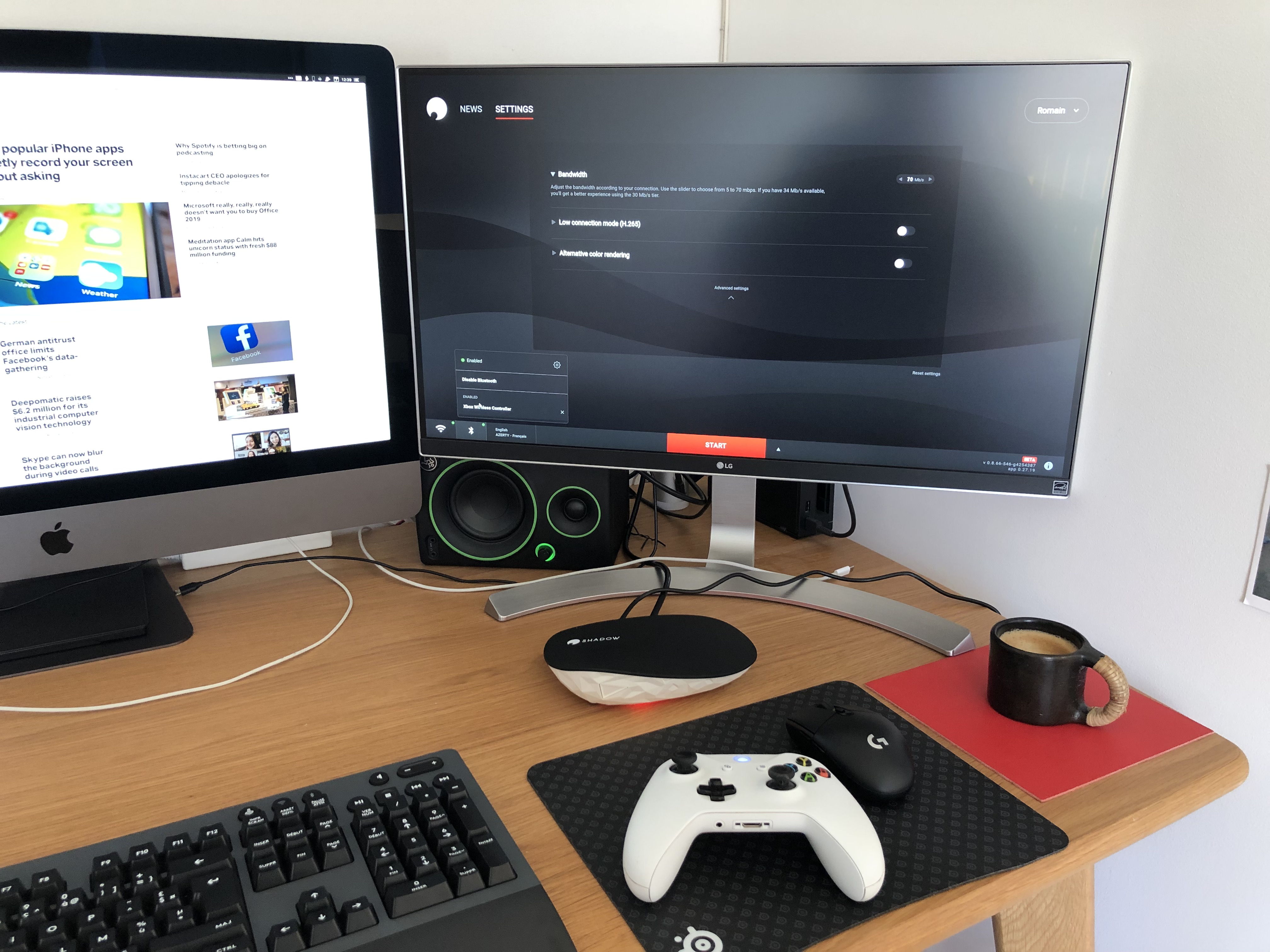
A gold rush
Cloud gaming is a hot space right now. While some companies have been experimenting with this concept for a while (Nvidia, Sony), it feels like everyone is working on a new service of some sort. Maybe the next Xbox is going to be about streaming a game from a data center. Maybe Amazon will offer a game library in the cloud as part of your Amazon Prime subscription.
Emmanuel Freund believes that it could be an opportunity for Shadow. Everybody is going to talk about cloud gaming if Apple and Google announce new services. But the startup has years of experiences in the space and has tried hard to compensate when it comes to latency and internet speeds.
It’s going to be harder to compete on content though. Game publishers and console manufacturers could start releasing exclusive titles on their cloud gaming services. That’s why Blade is thinking about new gaming experiences and exclusive content that would make Shadow more than a technical service.
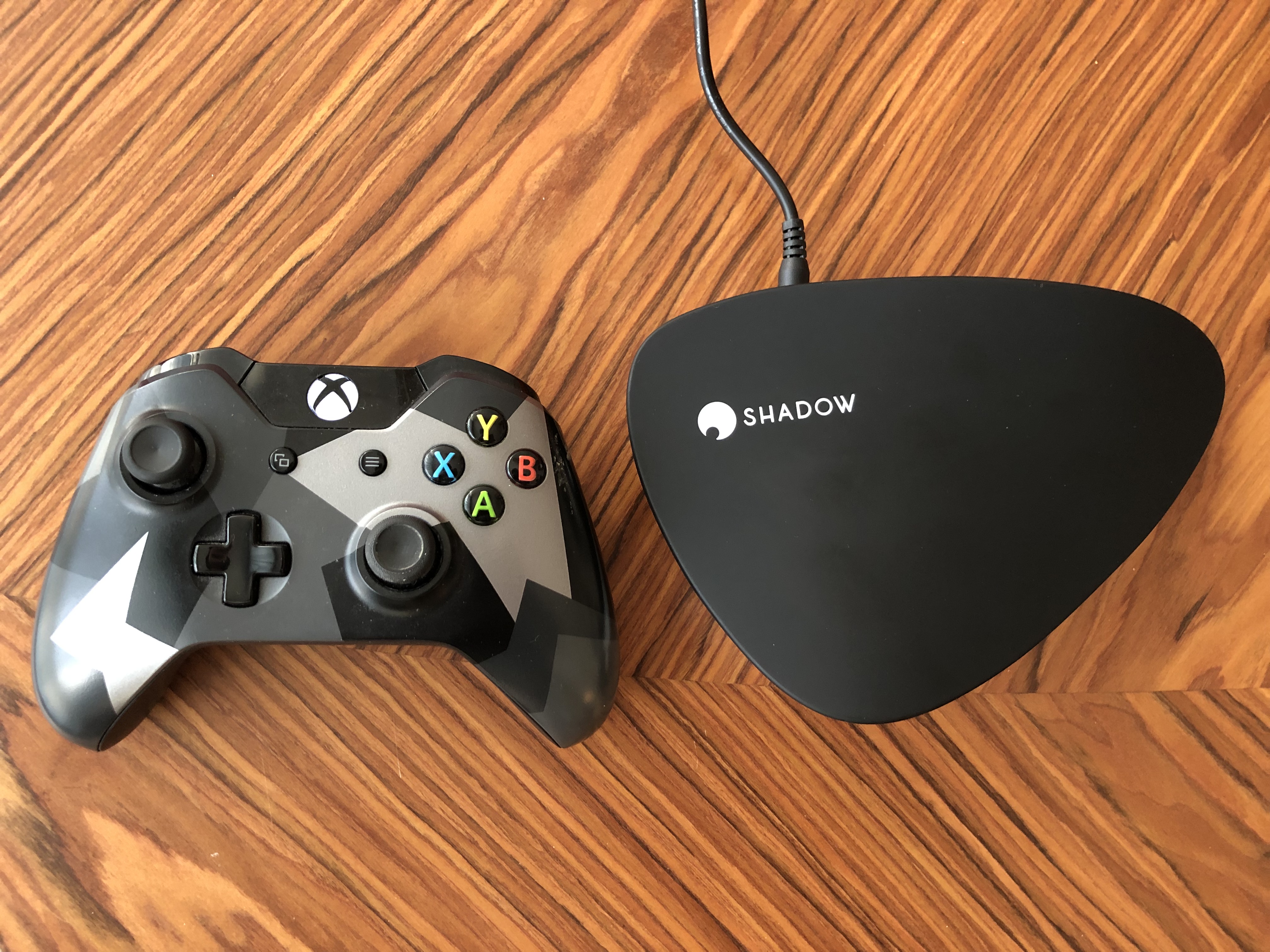
(Controller for scale)
Powered by WPeMatico
Threads emerges from stealth with $10.5M from Sequoia for a new take on enabling work conversations
The rapid rise of Slack has ushered in a new wave of apps, all aiming to solve one challenge: creating a user-friendly platform where coworkers can have productive conversations. Many of these are based around real-time notifications and “instant” messaging, but today a new startup called Threads coming out of stealth to address the other side of the coin: a platform for asynchronous communication that is less time-sensitive, and creating coherent narratives out of those conversations.
Armed with $10.5 million in funding led by Sequoia, the company is launching a beta of its service today.
Rousseau Kazi, the startup’s CEO who co-founded threads with Jon McCord, Mark Rich and Suman Venkataswamy, cut his social teeth working for six years at Facebook (with a resulting number of patents to his name around the mechanics of social networking), says that the mission of Threads is to become more inclusive when it comes to online conversations.
“After a certain number of people get involved in an online discussion, conversations just break and messaging becomes chaotic,” he said. (McCord and Rich are also Facebook engineering alums, while Venkataswamy is a Bright Roll alum.)
And if you have ever used Twitter, or even been in a popular channel in Slack, you will understand what he is talking about. When too many people begin to talk, the conversation gets very noisy and it can mean losing the “thread” of what is being discussed, and seeing conversation lurch from one topic to another, often losing track of important information in the process.
There is an argument to be made for whether a platform that was built for real-time information is capable of handling a difference kind of cadence. Twitter, as it happens, is trying to figure that out right now. Slack, meanwhile, has itself introduced threaded comments to try to address this too — although the practical application of its own threading feature is not actually very user friendly.
Threads’ answer is to view its purpose as addressing the benefit of “asynchronous” conversation.
To start, those who want to start threads first register as organizations on the platform. Then, those who are working on a project or in a specific team creates a “space” for themselves within that org. You can then start threads within those spaces. And when a problem has been solved or the conversation has come to a conclusion, the last comment gets marked as the conclusion.
The idea is that topics and conversations that can stretch out over hours, days or even longer, around specific topics. Threads doeesn’t want to be the place you go for red alerts or urgent requests, but where you go when you have thoughts about a work-related subject and how to tackle it.
These resulting threads, when completed or when in progress, can in turn be looked at as straight conversations, or as annotated narratives.
For now, it’s up to users themselves to annotate what might be important to highlight for readers, although when I asked him, Kazi told me he would like to incorporate over time more features that might use natural language processing to summarize and pull out what might be worth following up or looking at if you only want to skim read a longer conversation. Ditto the ability to search threads. Right now it’s all based around keywords but you can imagine a time when more sophisticated and nuanced searches to surface conversations relevant to what you might be looking for.
Indeed, in this initial launch, the focus is all about what you want to say on Threads itself — not lots of bells and whistles, and not trying to compete against the likes of Slack, or Workplace (Facebook’s effort in this space), or Yammer or Teams from Microsoft, or any of the others in the messaging mix.
There are no integrations of other programs to bring data into Threads from other places, but there is a Slack integration in the other direction: you can create an alert there so that you know when someone has updated a Thread.
“We don’t view ourselves as a competitor to Slack,” Kazi said. “Slack is great for transactional conversation but for asynchronous chats, we thought there was a need for this in the market. We wanted something to address that.”
It may not be a stated competitor, but Threads actually has something in common with Slack: the latter launched with the purpose of enabling a certain kind of conversation between co-workers in a way that was easier to consume and engage with than email.
You could argue that Threads has the same intention: email chains, especially those with multiple parties, can also be hard to follow and are in any case often very messy to look at: something that the conversations in Threads also attempt to clear up.
But email is not the only kind of conversation medium that Threads thinks it can replace.
“With in-person meetings there is a constant tension between keeping the room small for efficiency and including more people for transparency,” said Sequoia partner Mike Vernal in a statement. “When we first started chatting with the team about what is now Threads, we saw an opportunity to get rid of this false dichotomy by making decision-making both more efficient and more inclusive. We’re thrilled to be partnering with Threads to make work more inclusive.” Others in the round include Eventbrite CEO Julia Hartz, GV’s Jessica Verrilli, Minted CEO Mariam Naficy, and TaskRabbit CEO Stacy Brown-Philpot.
The startup was actually formed in 2017, and for months now it has been running a closed, private version of the service to test it out with a small amount of users. So far, the company sizes have ranged between 5 and 60 employees, Kazi tells me.
“By using Threads as our primary communications platform, we’ve seen incredible progress streamlining our operations,” said one of the testers, Perfect Keto & Equip Foods Founder and CEO, Anthony Gustin. “Internal meetings have reduced by at least 80 percent, we’ve seen an increase in participation in discussion and speed of decision making, and noticed an adherence and reinforcement of company culture that we thought was impossible before. Our employees are feeling more ownership and autonomy, with less work and time that needs to be spent — something we didn’t even know was possible before Threads.”
Kazi said that the intention is ultimately to target companies of any size, although it will be worth watching what features it will have to introduce to help handle the noise, and continue to provide coherent discussions, when and if they do start to tackle that end of the market.
Powered by WPeMatico
Apple removes VoIP app clones from the App Store
Following my report from yesterday, Apple has removed many of the apps I pointed out. When you try to find them on the App Store, they are no longer available.
App Store Review Guidelines are very clear when it comes to app duplicates. According to rule 4.3, you can’t release the same app multiple times on the App Store as it is considered as spamming.
But that rule has been poorly enforced, and some companies have taken advantage of that. In my original report, I focused on one category in particular — VoIP apps that let you get a second phone number and send and receive calls and texts from that new number.
Developers release multiple versions of the same app so they can use different names, different keywords and different categories. This way, they can cover a wide range of keywords when you’re searching for an app in the App Store.
So let’s look at the developers I called out yesterday. It’s still unclear if some of these apps will reappear after some changes.
TextMe, Inc.
- TextMe Up Second Phone Number — REMOVED
- Free Tone – Calling & Texting — REMOVED
- Text Me – Phone Calls + Text — REMOVED
BinaryPattern and Flexible Numbers LLC
- Texting/Calling Phone Burner — STILL AVAILABLE
- Smiley Private Texting SMS — STILL AVAILABLE
- Texting Shield – Phone Number — REMOVED
- Burner Phone Numbers SMS/Calls — REMOVED
- Business Line Phone Number — REMOVED
Appverse Inc.
- Phoner 2nd Phone Number Text — REMOVED
- Text Burner – Texting Anonymous — REMOVED
- Second Line – 2nd Phone Number — REMOVED
Dingtone Inc.
- Dingtone – WiFi Calling & Text — REMOVED
- Telos Second Phone Number — REMOVED
This case illustrates once again that Apple holds the keys to the App Store kingdom. The company acts as a judge and can make or break some companies.
Some of those companies have released clones of their apps and benefited from that strategy for many years. The main issue here is that App Store rules aren’t enforced consistently.
Plenty of clones in other categories
The clone plague is far from over. Many categories also use this App Store optimization strategy.
JPEG Labs has released four different apps that let you print photos in Walgreens or CVS stores around you. They all do the same thing but have different names and keywords. (They also tell you to leave a review right after opening the app.)
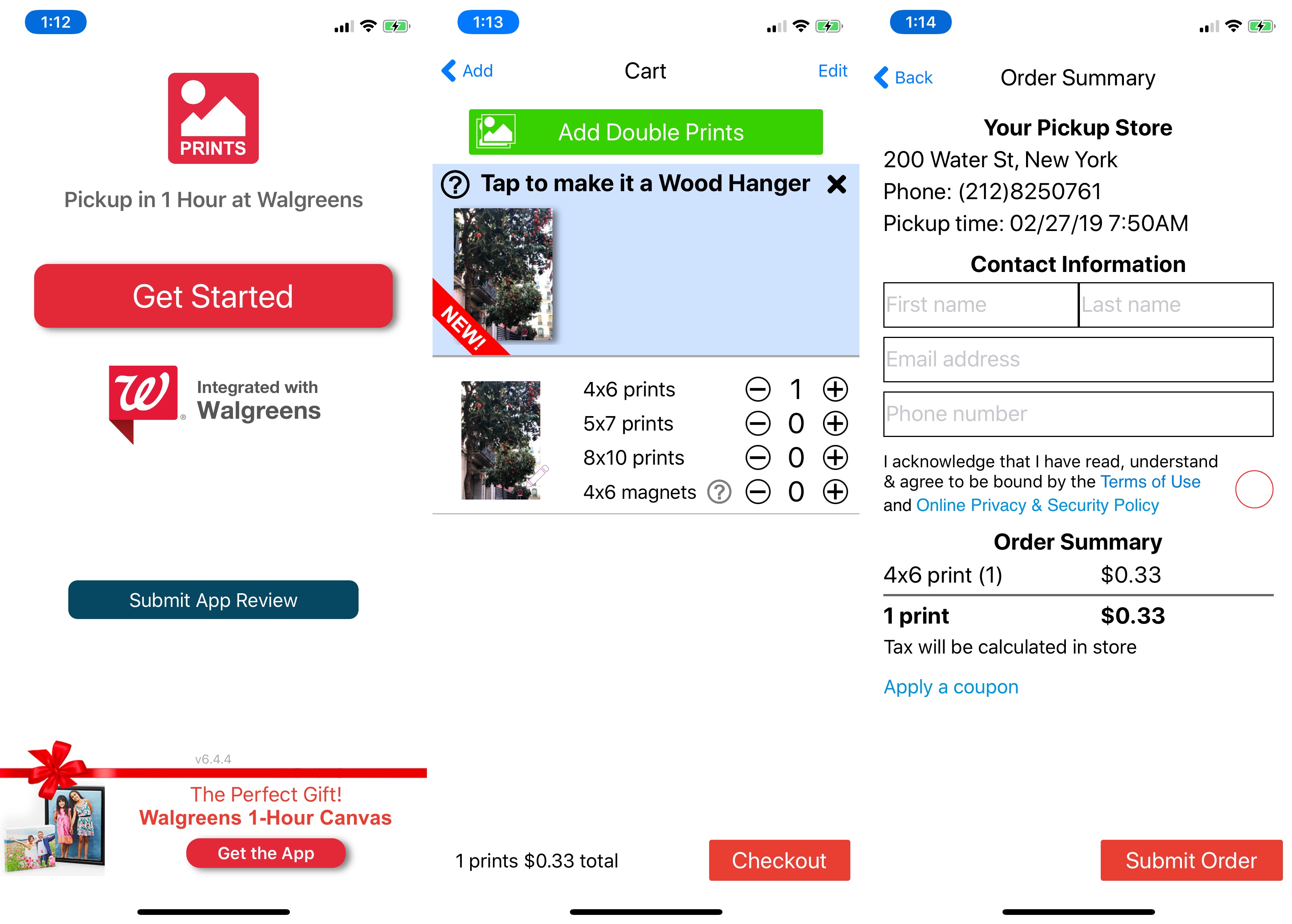
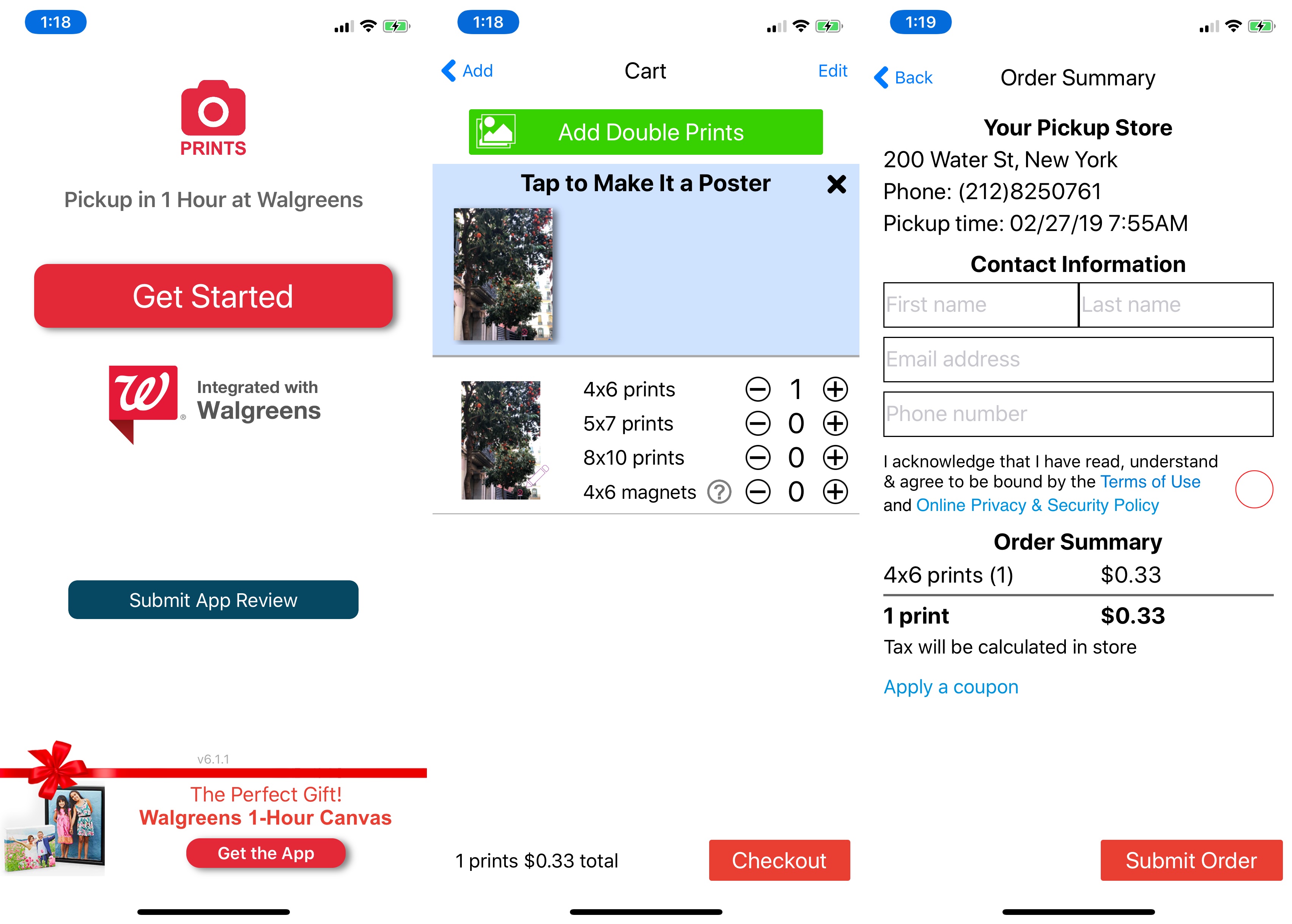
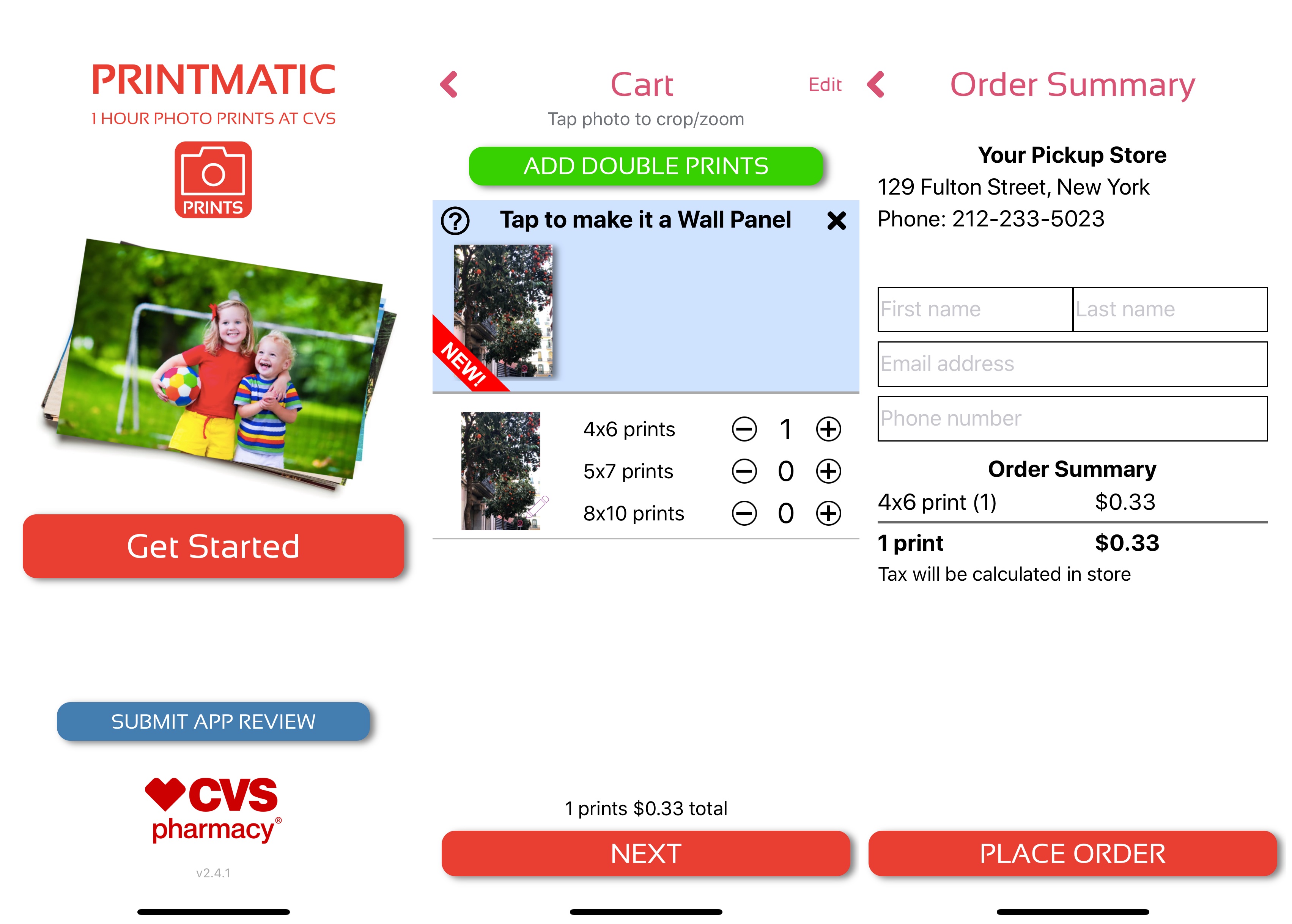
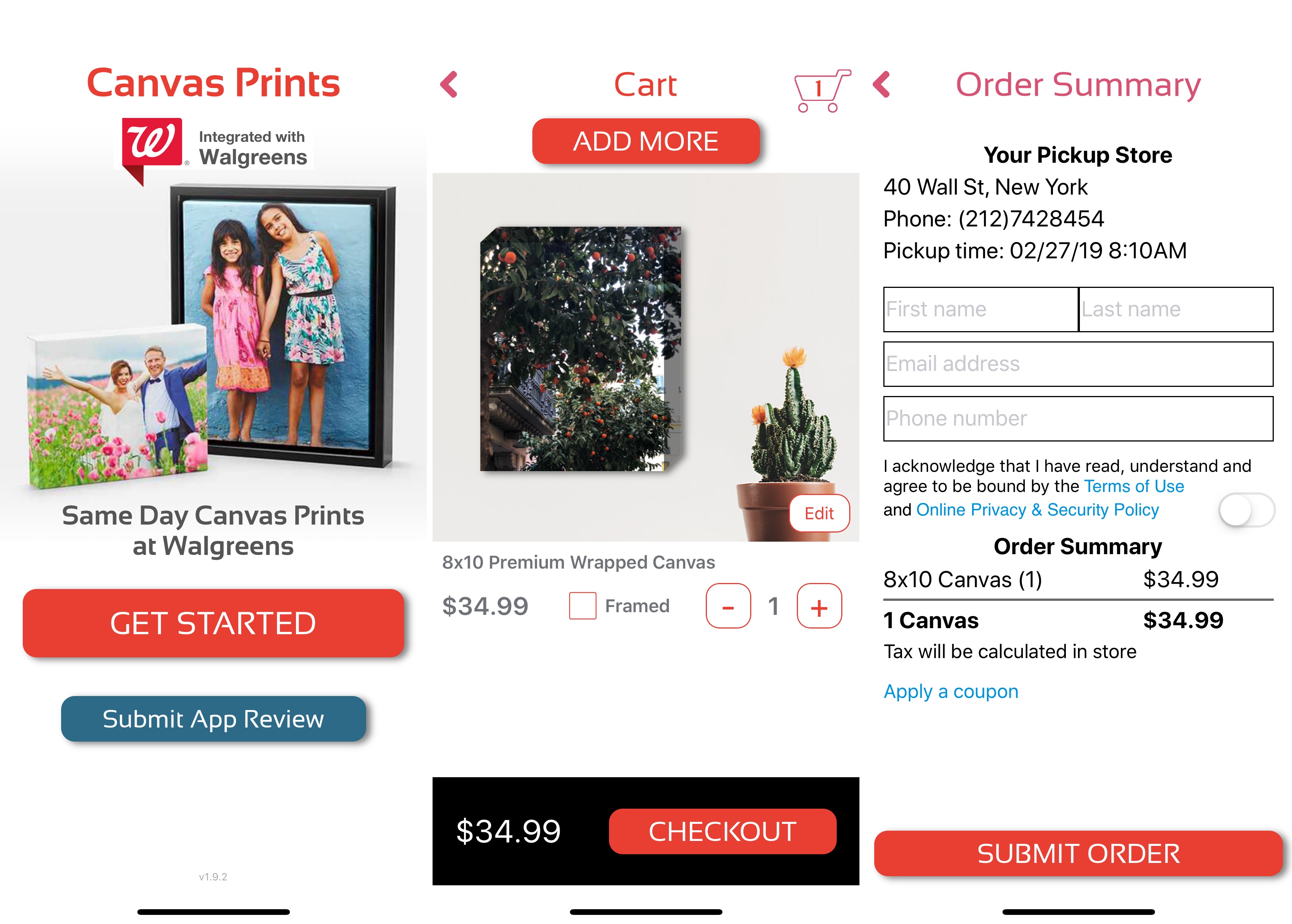
When you can’t beat them, acquire them
Another good example is MailPix, Inc. You can find multiple copies of the same app. The company is also slowly expanding its App Store footprint by acquiring competitors and changing those apps into duplicated versions of the main app.
MailPix acquired Photobucket’s printing app to turn it into a clone.
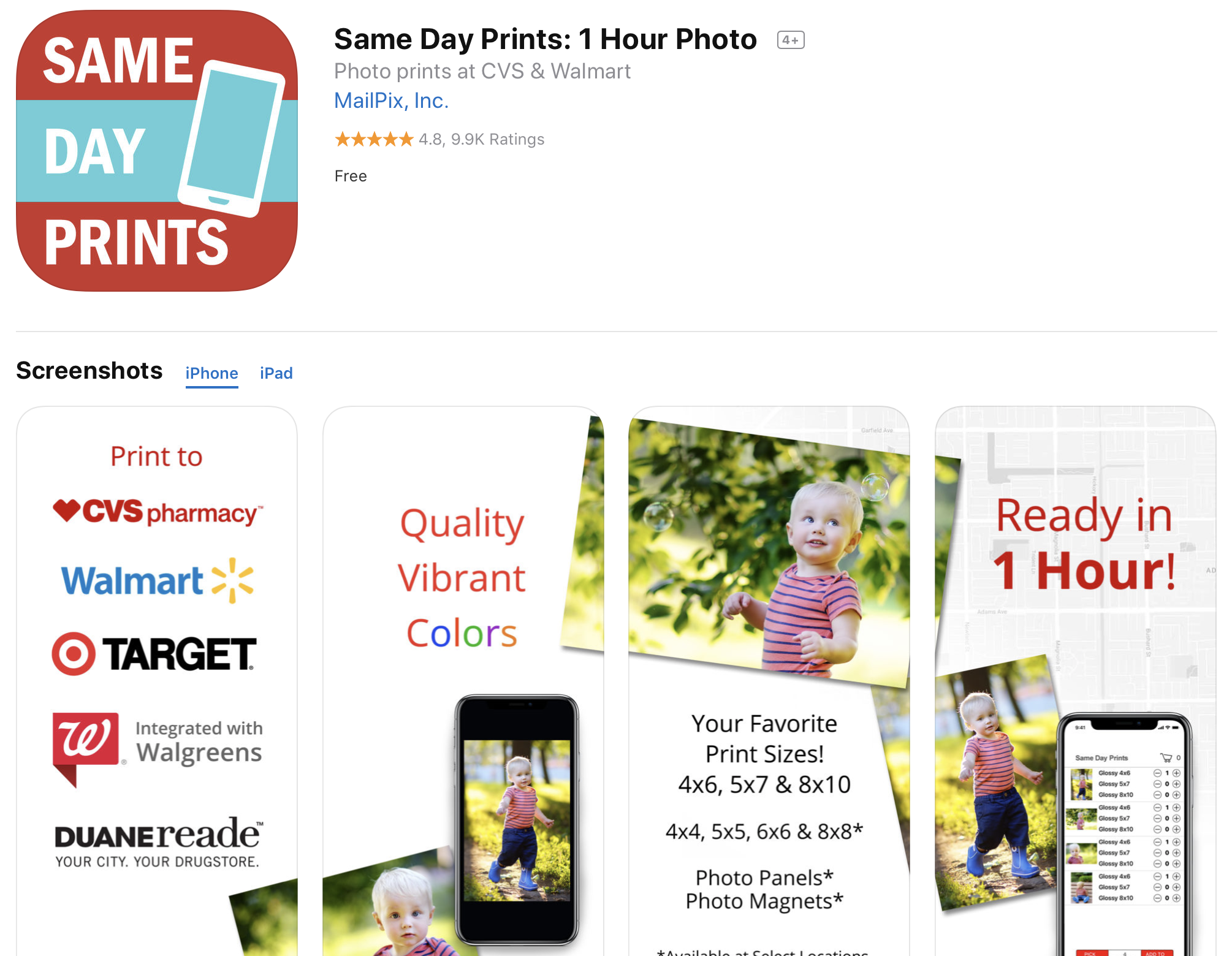
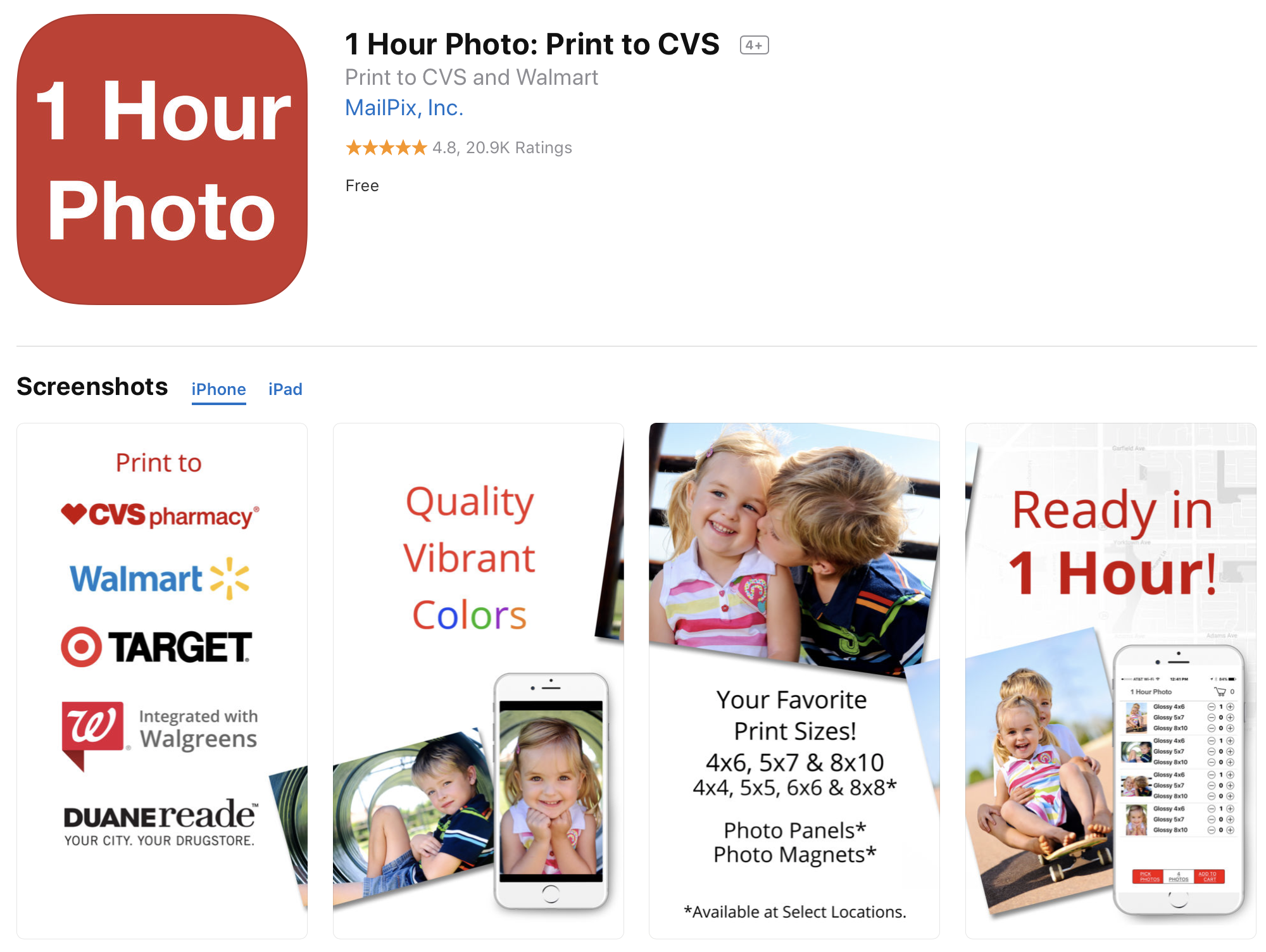
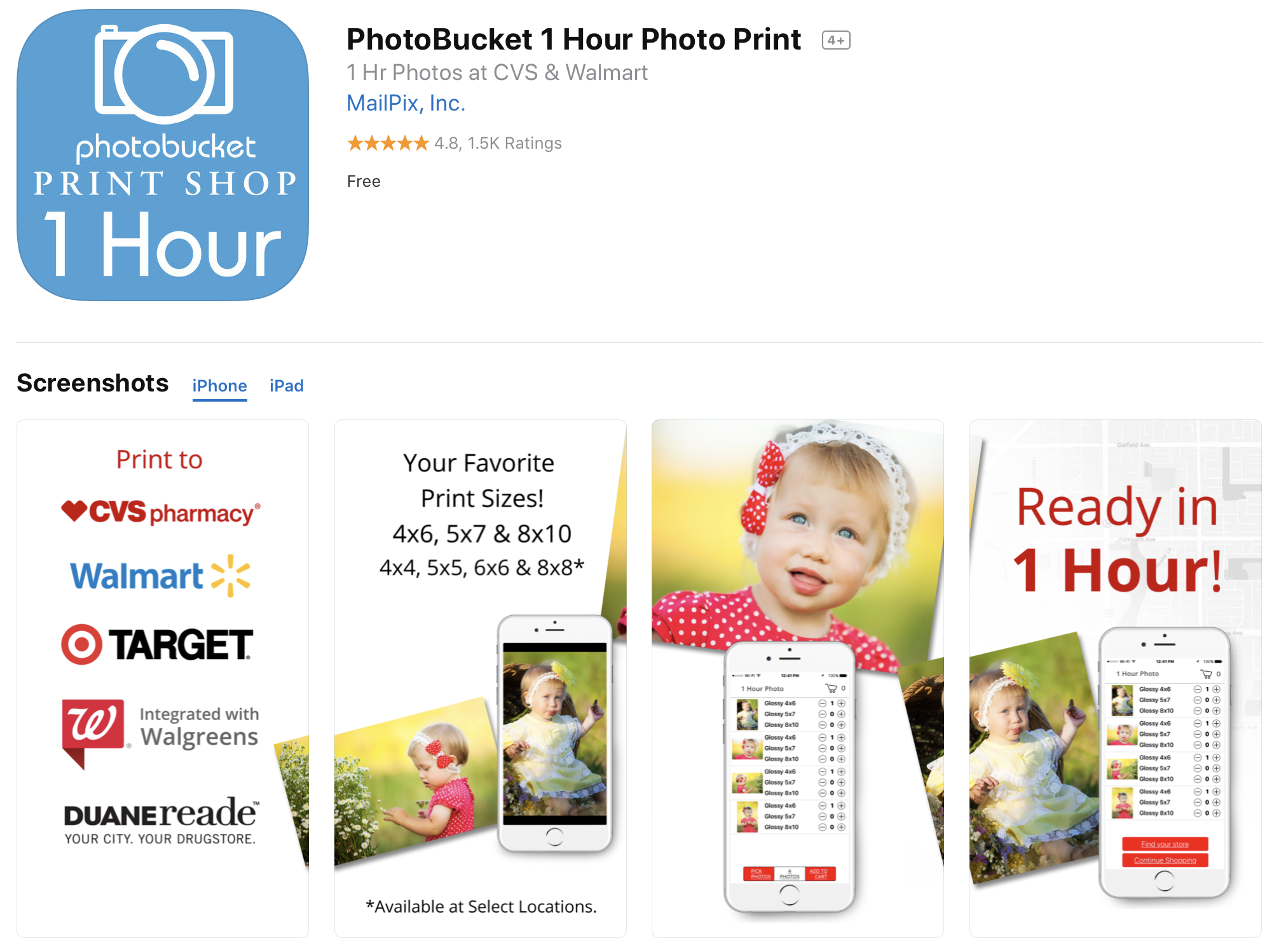
Powered by WPeMatico
When brands violate customer trust, it’s tough to win it back
Trust is a fundamental building block of any healthy relationship, whether that’s between individuals or companies and customers. If you can’t trust the company you are doing business with to do the right thing by you, it’s hard to continue the relationship. Too often, we have seen this trust broken when it comes to data sharing.
Last week, a Wall Street Journal article revealed a practice of apps sharing highly personal data with Facebook without user knowledge, whether the user had a Facebook account or not. In a follow-up article, the WSJ listed all 11 apps in its study (five of which stopped sharing data after being contacted by the publication). These included ovulation and heart-monitoring apps.
Whatever the reason, if your users aren’t aware that you are sharing their data in this fashion, and that would appear to be the case, then it’s a gross violation of trust between user and brand. Marc Benioff, co-CEO and co-founder at Salesforce, has often stated that trust is one of the primary components of a healthy brand-customer relationship. If you mess that up, it’s going to be very tough going for you as a business.
In an interview in September with Bloomberg’s Emily Chang, Benioff had this to say about trust. “Every CEO needs to ask themselves what is the most important thing to you. What is the most important thing to your company? What is your highest value? I know our highest value at Salesforce is trust. Nothing is more important than the trust that we have that we have with our customers or employees or partners or our top executives,” Benioff explained.
He went on to say when companies misuse customer’s data, they are breaking that trust and that could involve losing key personnel or customers. “When you see top executives walking out. When you see customers questioning your privacy practices or how you’re using or misusing their data or how you’re misusing partnerships, you need to listen. You need to wake up. You need to [ask] what is going on. It’s very serious,” Benioff said
If Benioff is right, and trust is the basis of all business relationships, then you’re playing with fire when you abuse the trust by sharing data with third parties without your customer’s knowledge, and sooner or later that’s going to come back and bite you as a brand.
Let’s face it, people stop using apps for a variety of reasons that have nothing to do with something as fundamental as trust. It could just be buggy or slow, but when the app is sending data to another company without user knowledge, it’s easy enough to just remove it from the phone and find another one that doesn’t do that (or at least you hope it doesn’t).
For brands, perception is everything. If people begin to think you are not looking out for their best interests, or are putting profit over common sense protections, it becomes difficult to turn around those negative feelings once they begin to harden.
If the brand continues to abuse its users time and again, it will eventually have an impact on revenue and begin to hurt your relationship with your existing customer base, and your ability to attract new customers to your products and services.
It seems like a risk that would be too big to take, yet we see brands take these risks time and again. If you don’t want to go that route, it’s pretty easy to prevent. Do right by your customers and they’ll continue to believe in you — or don’t, and watch what happens.
Powered by WPeMatico
Bring on the mobile weirdness
CES 2019 was a dud. It happens. Some years are more exciting than others. The world of technology ebbs and flows. Time is a flat circle. All that glitters is gold. Only shooting stars break the mold.
MWC, on the other hand — I’ve actually been pretty excited about this show for a while now. The mobile industry is at a crossroads. Smartphone sales have begun to stagnate and recede for the first time since analysts began tracking the things. Heck, this was the year the conference name officially changed from Mobile World Congress to MWC Barcelona.
That sort of sly rebranding takes some of the heavy lifting off the “mobile” bit for what has come to be regarded as the world’s premier smartphone launching pad. Don’t be too surprised to see the show attempt a shift into the broader world of consumer electronics, à la CES or IFA.
Meantime, smartphones are very much still the thing. The devices are still a ubiquitous part of our lives and will continue to be so for the foreseeable future. There are a number of reasons for the slowdown in sales, but the primary factors are slowed upgrade cycles and phones have gotten better and new features have become less compelling, coupled with rough economic trends in places like China, which were anticipated to be the primary driver for the category going forward.
The upshot of all of this is a newfound sense of experimentation. Keeping shareholders happy requires constant upward growth, and kickstarting sales will take some compelling reasons to upgrade. This year was the first time, perhaps since the original iPhone, that we’ve seen a radical shift in form factors, with Samsung, Huawei, TCL and Oppo all announcing foldable phones in the last couple of weeks.
Making sure they’re ready for prime time is another question altogether, but I’m definitely on-board for the manner of differentiation they bring. While it’s true that a number of major players all got on the foldable train at roughly the same time, we’ve seen some unique approaches as the industry scrambles to figure out the best way to utilize flexible technology.
The fact is that none of these are going to be big sellers out of the gate — the average price point, which is currently hovering around $2,000, will see to that. Huawei, for one, seems to have tempered its expectations around the category. Mobile chief Richard Yu quite nearly apologized for the price of the Mate X onstage the other day.
But the inability to pay double the price of a flagship smartphone shouldn’t be mistaken for a lack of interest, nor should it be used as justification for pulling back on experimentation. In a recent conversation, the CEO of Light discussed how the maturation of the smartphone category could afford smartphone makers the opportunity to better target different user needs.
He was speaking specifically about different camera arrays on the backs of phones, but I don’t see why that can’t apply to the space in broader terms. Plenty of smartphone makers have gotten burned trying to compete with similar products on the same field as Apple or Samsung.
For years, smartphones have constituted one of the very few consistent trends in an otherwise fragmented media landscape. It’s not too hard to imagine smartphones undergoing a similar transformation, in which smartphones are less uniform, but better suited to users’ individual needs.
Of course, it seems just as — if not more — likely that handset makers will ultimately pull the plug on any devices that fail to catch the world on fire. Just look at the recent rumors that Razer has abandoned plans for a third gaming phone.
Here’s hoping, however, that this year’s MWC marks the first step for a mobile space long overdue for a radical shakeup.
Powered by WPeMatico
We’re ready for foldable phones, but are they ready for us?
This is the moment we’ve been waiting for. After years of prototypes, the age of foldables has finally arrived. They’re here. I’ve seen them, and even, briefly, touched one.
And that’s about as far as it goes, to be honest. A week after Samsung kicked off its S10 event with an in-depth look at the Galaxy Fold, the device made its IRL debut at MWC, this week. We got to the show an hour early on the first day, only to find four devices trapped behind glass cases.
They weren’t doing much of anything at all. Two were splayed to show the backs of the devices and two showed off the screens. We were able to get within a few inches of the things before security swooped in and put up the ropes. The Fold has a release date that’s just under two months away, and yet here we are, stuck admiring the thing from afar.
Huawei was a bit better. Another morning session yesterday found us backstage at the company’s booth, getting up close and personal with the Mate X. But things got a little weird. I’m used to being babysat with pricey new devices, but Huawei went out of its way to severely limit interactivity with the product, as noted in the story.

TCL’s product got a similar behind-glass treatment as the Fold. Though there’s one key difference: the company gave a 2020 time frame for its more affordable (more affordable than $2,600, that is) take on the category. That, hopefully, is enough time to work out all of the kinks ahead of product launch.
That neither Huawei nor Samsung feel confident enough to let us go a bit more in-depth with their soon-to-be-released devices isn’t the kind of thing that really instills one with confidence in an emerging space. Royole, to its credit, let the press go fully hands-on with its products back at CES, though, by nearly all accounts, the product feels more like a developer device than anything.
And that, really, is the fear. Samsung’s charging an arm and a leg for the device, at $1,980. Huawei’s tossed in another limb, bringing the total up to $2,600. That’s not beta-tester levels. That’s double the cost of already exorbitant flagship smartphone pricing for products that appear to still have a lot of bugs to work out.
It’s true that there’s a lot that needs to be redesigned after generations of coalescing around the same basic form factor, both from a hardware and software perspective. But it’s one thing to announce a concept and another entirely to bring it to market. If these initial devices ultimately prove buggy or are otherwise a letdown from a user perspective, it’s going to be a fairly inauspicious start for a long-promised form factor.
Powered by WPeMatico
Steam fights for future of game stores and streaming
For more than 15 years, Steam has been the dominant digital distribution platform for PC video games. While its success has spawned several competitors, including some online stores from game publishers, none have made a significant dent in its vice-like grip on the market.
Cracks, though, are seemingly starting to appear in Steam’s armor, and at least one notable challenger has stepped up, with potentially bigger ones on the horizon. They threaten to make Steam the digital equivalent of GameStop — a once unassailable retail giant whose future became questionable when it didn’t successfully change with the times.
The epic launch of an Epic Store

Photo by Neilson Barnard/Getty Images for Ubisoft
Epic Games has, in a remarkably short period of time, positioned itself as the successor to Steam. In December, the creator of the billion-dollar Fortnite franchise announced it was getting into the game retail business with the Epic Games store. Less than two months later, it had landed limited exclusivity deals with two publishers that chose to bypass Steam as they launch upcoming titles.
First up was Ubisoft, which announced the PC version of Tom Clancy’s The Division 2, a highly anticipated action game, would be semi-exclusive to the Epic Games store (it will also be available on Ubisoft’s digital storefront). Ubisoft also said that “additional select titles” would be coming to Epic’s store in later months.
“We’re giving game developers and publishers the store business model that we’ve always wanted as developers ourselves,” said Tim Sweeney, founder and CEO of Epic Games. “Ubisoft supports our model and trusts us to deliver a smooth journey for players, from pre-purchase to the game’s release.”
Three weeks later, publisher Deep Silver abruptly discontinued pre-sales of its survival shooter Metro Exodus on Steam and announced the game would be available moving forward solely through the Epic Games store (previous Steam orders will be honored).
Steam’s past success is hitting new blocks
To be clear, Steam is hardly struggling. Last October at Melbourne Games Week, Steam announced it had 90 million monthly active users, compared to 67 million in 2017. Daily active users, it said, had grown from 33 million to 47 million.
Much of that growth came from China, where players are looking to circumvent the government’s crackdown on games. Domestic numbers, though, have been trending down, according to SteamSpy, a third-party tracking service.
Valve Software, which owns Steam, did not reply to requests for comment on this story. It did, however, post a statement on the Metro Exodus Steam page soon after Deep Silver announced its partnership with Epic, saying, “We think the decision to remove the game is unfair to Steam customers, especially after a long pre-sale period. We apologize to Steam customers that were expecting it to be available for sale through the February 15th release date, but we were only recently informed of the decision and given limited time to let everyone know.”
So what’s the draw for game makers to sell via the Epic Games store? It is, of course, a combination of factors, but chief among those is financial. To convince publishers and developers to utilize their system, Epic only takes a 12 percent cut of game-sale revenues. That’s significantly lower than the 30 percent taken by Valve on Steam (or the amounts taken by Apple or Google in their app stores).
To woo developers who use its Unreal graphics engine, Epic also waives all royalty fees for sales generated through the store. (Developers who use Unreal in their games typically pay a 5 percent royalty on all sales.)
The reason for those notably lower commissions, perhaps not surprisingly, ties back to Fortnite.
“While running Fortnite we learned a lot about the cost of running a digital store on PC,” says Sweeney. “The math is simple: we pay around 2.5 percent for payment processing for major payment methods, less than 1.5 percent for CDN [content delivery network] costs (assuming all games are updated as often as Fortnite), and between 1 percent and 2 percent for variable operating and customer support costs. Because we operate Fortnite on the Epic Games launcher on such a large scale, it has enabled us to build the store, run it at a low cost and pass those savings onto developers.”
Owning the game customer

Photo by Andy Cross/The Denver Post via Getty Images
Higher commissions are just one of the issues developers and publishers have with Steam. While none were willing to go on the record, for fear of retribution from Valve or because they were not authorized to officially speak on their company’s behalf, the complaints generally echoed each other.
Powered by WPeMatico



